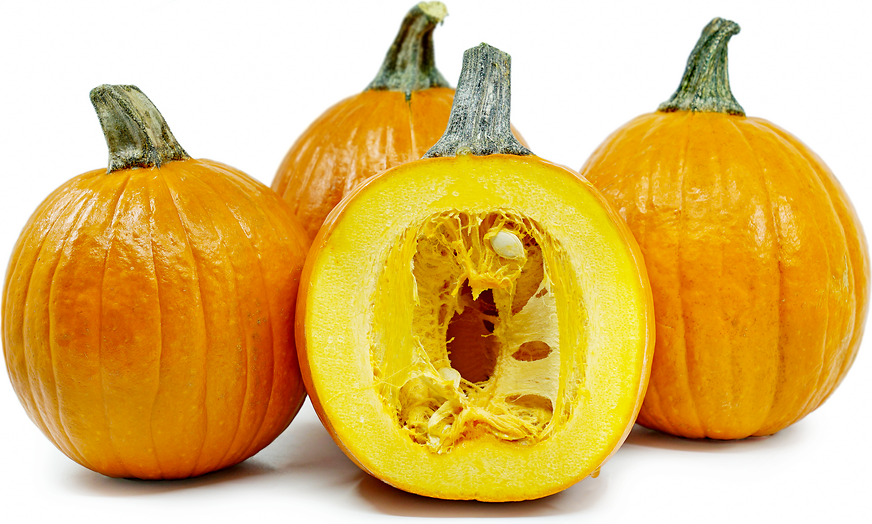


Pam Pumpkins
Estimated Inventory, 20 ct : 0
Description/Taste
Pam pumpkins are a medium-sized variety that typically measures 15 to 20 centimeters in diameter and weighs between 1.75 and 3 kilograms. These pumpkins have a uniform oval shape with a bright orange rind, shallow ribbing, and a five-sided rough brown-green stem. The rind is smooth, shiny, and firm and may have barely visible bumps along its surface. Pam pumpkin flesh is pale orange-yellow with a dense, moist, and thick texture. This flesh encases a large central cavity filled with stringy, fibrous pulp and flat cream-colored seeds. Pam pumpkins have a tender, smooth, and stringless texture when cooked and a sweet, sugary flavor.
Seasons/Availability
Pam pumpkins are available from fall to winter.
Current Facts
Pam pumpkins are botanically classified as Cucurbita pepo and belong to the Cucurbitaceae family along with squash, gourds, and cucumbers. They are also referred to as Hybrid Pam pumpkins and are considered to be one of the best pie pumpkins on the market today because of their uniform size, tender flesh, and sweet flavor. This variety is the parent of the more common Baby Pam pumpkin which is a miniature version of the original Pam. The other parent is the New England Cheddar pumpkin variety that has a significantly flatter shape and pale orange-tan rind. The popularity of Pam pumpkins can be partially attributed to their ability to produce high yields in small spaces. They are primarily a culinary pumpkin but can also be used for carving jack-o'-lanterns and fall home décor projects.
Nutritional Value
Pam pumpkins are rich in vitamin A that supports healthy vision and immune function. They also contain vitamins C and E which help with collagen production, iron absorption, wound and skin healing, eye health, and inflammation reduction. They provide the body with minerals like potassium, magnesium, and phosphorus. These nutrients support fluid balance, healthy blood pressure levels, nerve and muscle function, bone and tooth health, energy production, and cell repair and growth. Pam pumpkins have copper and manganese that help prevent cell damage and infections and aid in healthy blood vessels and blood sugar levels. The iron in these pumpkins can support brain function by encouraging cognition and focus.
Applications
Pam pumpkins are best suited for cooked applications such as roasting, steaming, baking, and puréeing. They are frequently used to make pumpkin pies as well as other baked goods like muffins, tarts, breads, cakes, fritters, and empanadas. These pumpkins also bode well for colder desserts like custard, pudding, ice cream, and cheesecake. Pam pumpkins may be incorporated into savory recipes when puréed or diced and roasted with olive oil and herbs. They can be mixed into soups, stews, curries, chilis, quesadillas, tamales, lasagnas, pasta, and ravioli. Their creamy texture works for queso dips made with goat, swiss, mozzarella, or cream cheese. Pam pumpkins pair well with chicken, sausage, pork, Gruyere, Parmesan, French bread, shallots, onions, garlic, ginger, white wine, Swiss chard, Dijon mustard, miso paste, thyme, oregano, rosemary, cumin, and peanuts. They will keep for 2 to 3 months when stored in a cool place.
Ethnic/Cultural Info
The Pam variety is known for being an ideal choice for making a classic pumpkin pie. This famous American dessert was first enjoyed by early settlers at the beginning of the 17th century. It was made by stewing pumpkins and baking them with milk, honey, and spices. In 1796 an official recipe for pumpkin pie was published in American Cookery, the first cookbook written in the United States. This work was authored by Amelia Simmons and is considered one of the most significant insights into the culinary practices of the colonists. Demand for sweet pumpkins that could be made into pies then grew and varieties with sugary flesh started being developed.
Geography/History
Pam pumpkins were created by the Seedway Company of Hall, New York in 1998. They grow in temperate climates with warm summers and mild winters. This cultivated variety is frequently sown in home gardens and produced commercially. Pam pumpkins were developed to meet the demand for pumpkins with sweet, flavorful flesh suited for making pies and other baked goods. The focus on pumpkins for carving and fall decorations left an opening in the market for varieties designed specifically for culinary use. Pam pumpkins are now available at farmers' markets, specialty grocers, and through online seed catalogs for home gardening in the United States and Canada.
Recipe Ideas
Recipes that include Pam Pumpkins. One
| Noob Cook |
|
Pumpkin Soup in Pumpkin Bowl |




